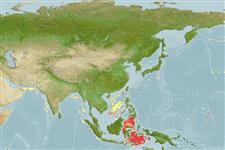>
Lophiiformes (Anglerfishes) >
Oneirodidae (Dreamers)
Etymology: Oneirodes: Greek, 'oneiros' = a dream or dreamlike or out of a dream (suggesting this fish is so strange and marvelous that can exist only in dreams) (Ref. 86949).
Eponymy: Dr Ernst Johannes Schmidt (1877–1933) was a Danish biologist who became the Director of the Laboratoire Carlsberg (1909–1933). [...] (Ref. 128868), visit book page.
More on authors: Regan & Trewavas.
Environment: milieu / climate zone / depth range / distribution range
นิเวศวิทยา
เกี่ยวกับทะเล,น้ำเค็ม สัตว์ผิวน้ำในเขตน้ำลึก; ระดับความลึก ? - 2500 m (Ref. 40966). Deep-water
Indo-West Pacific.
ขนาด / น้ำหนัก / Age
Maturity: Lm ? range ? - ? cm
Max length : 9.2 cm SL เพศผู้/กระเทย; (Ref. 26783)
Short description
เครื่องมือที่ใช้ในการแยกชนิดสัตว์,สิ่งมีชีวิตออกจากกัน | สัณฐานวิทยา | ความยาวต่างๆ
ก้านครีบอ่อนที่หาง (รวม) : 5 - 6; ก้านครีบอ่อนที่ก้น: 4. Characterized by having escal morphology: esca with large complex anterior appendage consisting of a wide compressed base bearing a relatively short unpaired branched filament on posterior margin, 2 extremely long distal filaments that bifurcate as many as five times, and a stout, bifurcated medial filament, each branch becomes highly branched distally; pair of filamentous, highly branched medial escal appendages less than length of escal bulb; terminal escal papilla with a single distal streak of pigment; slender unbranched posterior escal appendage less than length of escal bulb; relatively short, filamentous, branched anterolateral appendage on each side; long and narrow subopercle, dorsal end tapering, rounded or pointed distally, without indentation on posterodorsal margin; length of ventral fork of opercle 26.6-27.7% SL; ratio of lengths of the dorsal and ventral forks of opercle 0.47-0.51; absence of epibranchial teeth; presence of teeth on pharyngobranchial II; upper jaw teeth 60-67, lower jaw teeth 56-76; teeth on vomer 5-6; dorsal fin rays 5-6; anal fin rays 4; pectoral fin rays 15-17; head length 43.8-47.7% SL; head depth 42.4-50.0% SL; premaxilla length 35.9-40.0% SL; length of lower jaw 50.0-52.7% SL; length of illicium 37.5-107.7% SL (Ref. 86949).
Life cycle and mating behavior
วัยเจริญพันธุ์ | การสืบพันธุ์ | การวางไข่ | เซลสืบพันธ์ของเพศเมีย(ไข่) | ความดกของไข่ | ตัวอ่อน
Pietsch, T.W., 1999. Oneirodidae. Dreamers (deep-sea anglerfishes). p. 2031-2032. In K.E. Carpenter and V.H. Niem (eds.) FAO species identification guide for fishery purposes. The living marine resources of the WCP. Vol. 3. Batoid fishes, chimaeras and bony fishes part 1 (Elopidae to Linophrynidae). FAO, Rome. (Ref. 12940)
IUCN Red List Status (Ref. 130435: Version 2024-2)
Threat to humans
Harmless
Human uses
เครื่องมือ
Special reports
Download XML
แหล่งที่มาจากอินเตอร์เน็ต
Estimates based on models
Preferred temperature (Ref.
123201): 2.4 - 3.6, mean 3.1 °C (based on 458 cells).
Phylogenetic diversity index (Ref.
82804): PD
50 = 0.5000 [Uniqueness, from 0.5 = low to 2.0 = high].
Bayesian length-weight: a=0.01995 (0.00906 - 0.04395), b=3.01 (2.83 - 3.19), in cm total length, based on all LWR estimates for this body shape (Ref.
93245).
ระดับชั้นอาหาร (Ref.
69278): 3.9 ±0.7 se; based on size and trophs of closest relatives
ความสามารถในการกลับคืนสู่ปกติ (Ref.
120179): ความสูง, เวลาต่ำสุดที่จะทำให้ประชากรเพิ่มขึ้นเป็น 2 เท่าใช้เวลาน้อยกว่า 15 เดือน (Preliminary K or Fecundity.).
Fishing Vulnerability (Ref.
59153): Low vulnerability (10 of 100).
